For this rhetorical analysis, the Lutheran Immigration and Refugee Services (LIRS) website will be the focus. LIRS is an organization that assists refugees and immigrants in the United States. For the website, the author, purpose, context, audience, and genre will be reviewed from the information gathered on the website. The structure and organization of the website will be analyzed also within these categories. LIRS is an easy to navigate webpage that is chalk full of valuable information about refugees and immigration, while it also fundraises and gathers volunteers, all in one website.
When the LIRS home page is accessed, it presents the most educational information about their organization, the work they do, as well as their volunteers and how one can donate.
The website is set-up in a user friendly manner. The navigation bar is located at the top and is organized logically for the user, as can be seen below.
![]()
The navigation bar is the source of all the different main pages, subpages, and information. The website is comprised of several authors and contributors, which are those from their leadership group and their organization. Some of these individuals are outlined in the below picture, which can be found on their website.
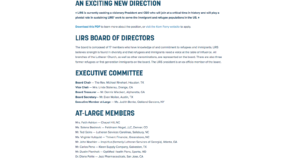
The organization establishes credibility through their background and history, as well as the stories they share about the people they have assisted. This information is presented on LIRS homepage, which can be seen below. First, the stories of the people LIRS have assisted are presented.
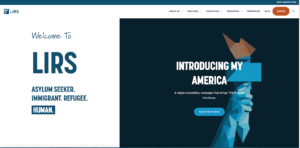
Then, the “About LIRS” page provides their mission statement and more information about their work.

While the website does present a bias, it is a trustworthy source. The reputation is that of non-profit work and the website helps to support that reputation. The home page presents the stories of immigrants, the about portion of LIRS, stating their mission statement, which is ““For almost 80 years, Lutheran Immigration and Refugee Service has been a champion for refugees and migrants from around the globe. Our history reflects American Lutherans’ deep immigrant roots and passionate commitment to welcoming newcomers, especially those who are most in need. Through the Long Welcome, we help ensure that refugees and migrants are protected, embraced, and empowered in a world of just and welcoming communities,” (Lutheran Immigration and Refugee Service, 2019).

The purpose of this website is to gain donations, educate the general population about their organization, as well as provide information and resources for those that are in need. The above image can be found on the main page of LIRS, while a separate donation page can also be found on the navigation bar at the top of the website. That donation page can be seen below.
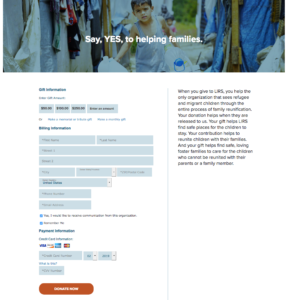
The website also helps to connect people, whether it is volunteers to refugees or those who wish to donate. The reader can conclude this information from their “About LIRS” page, their impact page, their page asking individuals to sign up for their newsletter, and their donation page. Their impact can be seen in the below image, which is a continuation of their about page.
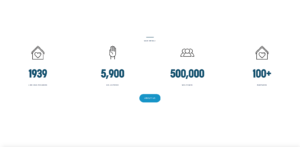
The medium of this resource is a website and it is used to reach the maximum amount of people, both with purpose of finding the website and general browsing. The website uses video within its site which is another mode that is utilized. A website is free to access and is accessible by anyone who has access to an electronic device. It provides the most information to the maximum amount of people. Although, a downside is that some refugees or immigrants may not access to technology. This organization is shown through a website, but it does have physical locations in Baltimore, as well as an office in D.C. The internet did not exist when the organization was created in 1939 so this outlet is relatively new and constantly changing (Lutheran Immigration and Refugee Service, 2019).
At the beginning of LIRS, it was operated out of Lutheran Churches (Lutheran Immigration and Refugee Service, 2019). At that time, newsprint, pamphlets, and word of mouth were important in connecting people. The website uses videos, pictures, and links to other resources within the site. Readers can watch videos, click links, read the information presented, and browse the entire website. One of those videos can be seen below, which is on the website’s volunteer page.
The intended audience would be those who are willing to donate to the organization, hence the large and orange donate button on the right hand side of the website, which distinguishes it from the rest of the navigation bar. The primary audience is also those who are immigrants and refugees that are looking for assistance. The secondary audience would be people that are looking to get involved and help, such as our class. The secondary audience also are those who just come across the website as they browse the internet. The people who want to donate to this type of organization and help volunteer are human rights activists that support non-profit organizations. The author and website appeal to these values and opinions by outlining the humanitarian work the organization does everyday. These values are outlined in the “About Us” page.
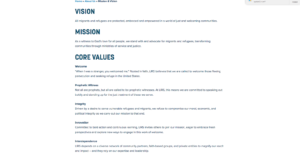
The genre of this website is a non-profit informational website. It is used as a resource for people to be involved in the organization, whether that is through volunteering or donating, as well as those who need information that are refugees or immigrants. In comparison to the other two websites provided (Maryland Immigrant Rights Coalition and Catholic Charities), the texts are very similar in set-up, context, genre, and audience. They all hope to achieve the same goal. The image below invites everyone who visits the site to join their newsletter to stay connected and involved with LIRS.

The website is uses mostly blue tones and white as its color scheme. Pictures of refugees, immigrants, asylum seekers, as well as people who work in the organization are presented on the site. People can access the website on their tablet, phone, computer, or laptop at any time they chose. The main page is organized in an interesting fashion because even though there are several things on the home page, they take up the entire screen to help the viewer distinguish the different categories.
Regardless of what sub page you visit, the footer is always there as well as the navigation bar for easy access. This is the footer of the website, which has their address, as well as the “fine print” details of the website and organization.

In this rhetorical analysis, the author, context, genre, purpose, and audience were reviewed and identified in detail in regards to the LIRS website. As these items were identified linguistically, a visual guide to the website was also presented for an enhanced understanding. This spatial organization allowed for the material to connect with the reader on a deeper level. The website is easy to navigate and is pleasing to the eye. The Lutheran Refugee and Immigration Services has created a powerful website to garner attention for their work, educate the masses, and call for fundraising and donations.
Works Cited:
“Lutheran Immigration and Refugee Service.” LIRS, 6 Feb. 2019, www.lirs.org/.